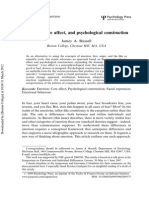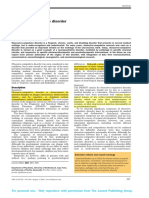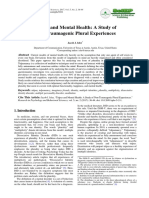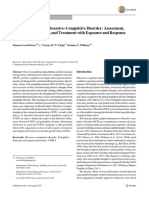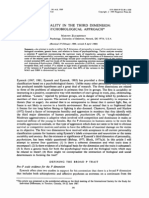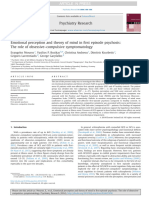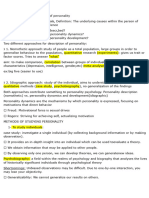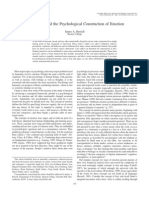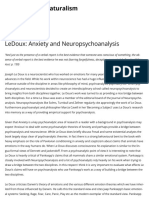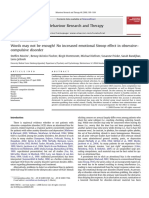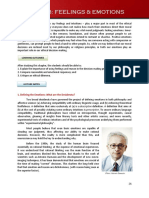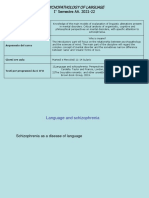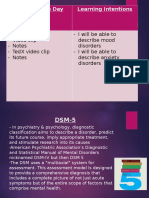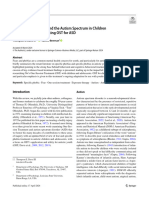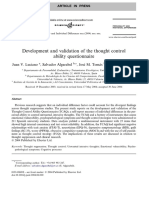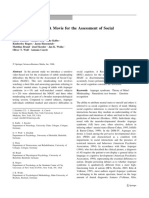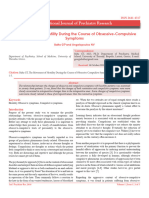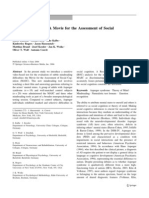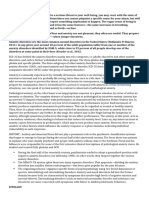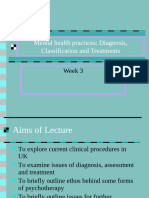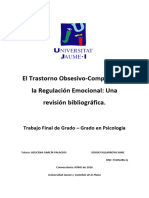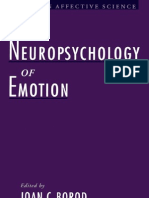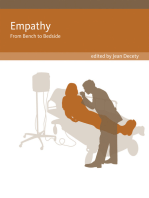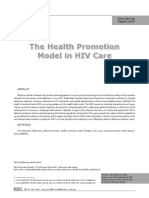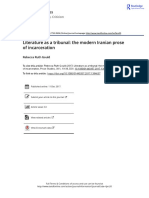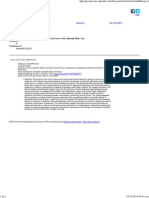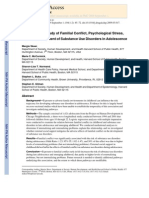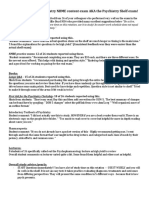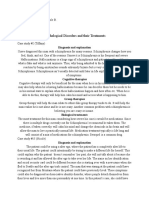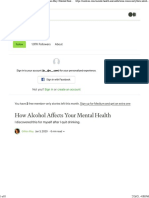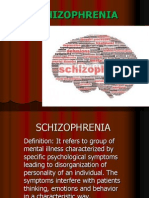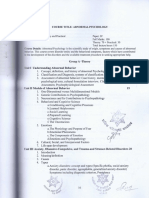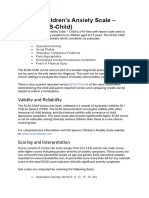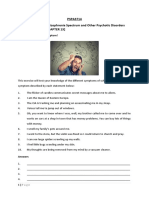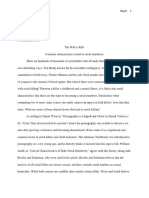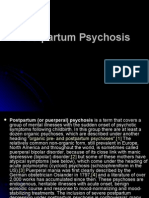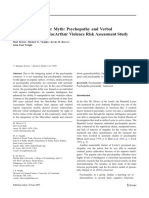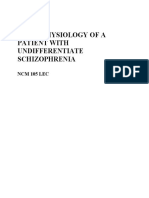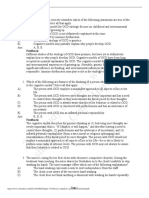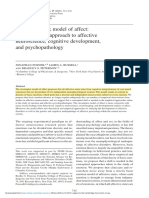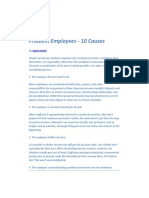0 ratings0% found this document useful (0 votes)
144 viewsAbout The Measure Domain Measure
About The Measure Domain Measure
Uploaded by
MaríaA.SerranoThe document provides information about the Dimensional Yale-Brown Obsessive-Compulsive Scale (DY-BOCS) protocol for measuring obsessive compulsive disorder symptoms. The DY-BOCS assesses the presence and severity of OCD symptoms including contamination, hoarding, symmetry, counting, religion, and aggression obsessions and compulsions. It includes both self-report and interviewer-administered sections to evaluate how much time is occupied by symptoms and how much distress and interference they cause. The protocol text provides instructions and examples of obsessions and compulsions for participants to consider when completing the questionnaire.
Copyright:
© All Rights Reserved
Available Formats
Download as DOC, PDF, TXT or read online from Scribd
About The Measure Domain Measure
About The Measure Domain Measure
Uploaded by
MaríaA.Serrano0 ratings0% found this document useful (0 votes)
144 views3 pagesThe document provides information about the Dimensional Yale-Brown Obsessive-Compulsive Scale (DY-BOCS) protocol for measuring obsessive compulsive disorder symptoms. The DY-BOCS assesses the presence and severity of OCD symptoms including contamination, hoarding, symmetry, counting, religion, and aggression obsessions and compulsions. It includes both self-report and interviewer-administered sections to evaluate how much time is occupied by symptoms and how much distress and interference they cause. The protocol text provides instructions and examples of obsessions and compulsions for participants to consider when completing the questionnaire.
Original Description:
gg
Original Title
02 Ocd Dybocs
Copyright
© © All Rights Reserved
Available Formats
DOC, PDF, TXT or read online from Scribd
Share this document
Did you find this document useful?
Is this content inappropriate?
The document provides information about the Dimensional Yale-Brown Obsessive-Compulsive Scale (DY-BOCS) protocol for measuring obsessive compulsive disorder symptoms. The DY-BOCS assesses the presence and severity of OCD symptoms including contamination, hoarding, symmetry, counting, religion, and aggression obsessions and compulsions. It includes both self-report and interviewer-administered sections to evaluate how much time is occupied by symptoms and how much distress and interference they cause. The protocol text provides instructions and examples of obsessions and compulsions for participants to consider when completing the questionnaire.
Copyright:
© All Rights Reserved
Available Formats
Download as DOC, PDF, TXT or read online from Scribd
Download as doc, pdf, or txt
0 ratings0% found this document useful (0 votes)
144 views3 pagesAbout The Measure Domain Measure
About The Measure Domain Measure
Uploaded by
MaríaA.SerranoThe document provides information about the Dimensional Yale-Brown Obsessive-Compulsive Scale (DY-BOCS) protocol for measuring obsessive compulsive disorder symptoms. The DY-BOCS assesses the presence and severity of OCD symptoms including contamination, hoarding, symmetry, counting, religion, and aggression obsessions and compulsions. It includes both self-report and interviewer-administered sections to evaluate how much time is occupied by symptoms and how much distress and interference they cause. The protocol text provides instructions and examples of obsessions and compulsions for participants to consider when completing the questionnaire.
Copyright:
© All Rights Reserved
Available Formats
Download as DOC, PDF, TXT or read online from Scribd
Download as doc, pdf, or txt
You are on page 1of 3
PhenX Toolkit Supplemental Information
Domain: Psychiatric
Release Date: June 30, 2010
Obsessive Compulsive Disorder DYBOCS
About the Measure
Domain Psychiatric
Measure Obsessive Compulsive Disorder (OCD)
Definition Obsessive Compulsive Disorder is an anxiety disorder characterized
by intrusive obsessions that cause distress or anxiety and
compulsions that alleviate the distress (American Psychiatric
Association, 2000).
About the Protocol
Description of The Dimensional Yale-Brown Obsessive-Compulsive Scale (DY-
Protocol BOCS) assesses the presence and severity of obsessive compulsive-
symptoms. It includes sections on contamination, hoarding,
symmetry, counting, religion, and aggression. This protocol includes
both self-report and interviewer-administered portions.
PhenX Toolkit Supplemental Information
Obsessive Compulsive Disorder DYBOCS
PhenX Toolkit Supplemental Information
Domain: Psychiatric
Release Date: June 30, 2010
Obsessive Compulsive Disorder DYBOCS
Protocol text Dimensional Yale-Brown Obsessive-Compulsive Scale
(DY-BOCS)
NOTE: This questionnaire asks about obsessive-compulsive
symptoms. We ask that you please complete all the questions that
follow.
When completing this questionnaire, please consider the
following:
Obsessions are upsetting repetitive and intrusive thoughts or
images. Examples include a recurring concern about whether a light
has been switched off or a door has been locked. Other examples
include worries about germs and diseases. These thoughts or images
continue even when the person tries to ignore or suppress them.
Compulsions are repetitive acts, behaviors or mental rituals
that the person feels he or she has to perform. For example, repeated
checking that the door is locked or appliances are off. Other examples
include repetitive hand washing or the need to place things in a
certain order.
In this scale obsessions and compulsions are grouped
together in six different dimensions. These dimensions are the result
of research studies indicating that a dimensional approach to OC
symptoms might be useful in clinical, genetic, neurobiological and
treatment response studies.
After reviewing an inventory of items for each symptom
dimension you will be asked to answer how much of your time is
occupied by those symptoms and how much distress and interference
they cause you.
Note: Frequently the content of obsessional thoughts and images
involves "harm" coming to self or others, especially close family
members. In this questionnaire we would like you to carefully consider
the specific nature of the harm. For example, in the first section you
will be asked to focus on obsessional worries about harm due to
contamination with dirt or germs. Later on you will be asked about
harm that is specifically due to accidents, violence, other forms of
aggressive behavior, and natural disasters or catastrophes. In another
section, we will ask you about obsessional worries related to harm
due to improper sexual or religious thoughts or actions. Please be
careful to endorse only the items that best typify your obsessions by
reading over the examples that are provided for each question.
Dimension 1: Obsessions about Harm due to Injury, Violence,
Aggression or Natural Disasters and Related Compulsions
Part A: Symptom Inventory
Please check one or more boxes in each row as appropriate ("past"
means that the symptom was present in the past but not during the
previous week). If a symptom has ever been present (current or past),
PhenX Toolkit Supplemental Information
Obsessive Compulsive Disorder DYBOCS
PhenX Toolkit Supplemental Information
Domain: Psychiatric
Release Date: June 30, 2010
Obsessive Compulsive Disorder DYBOCS
Participant Adult, ages 18 years and older
Child, ages 6 years and older
Source MC Rosario-Campos, EC Miguel, S Quatrano, P Chacon, Y Ferrao, D
Findley, L Katsovich, L Scahill, RA King, SR Woody, D Tolin, E
Hollander, Y Kano and JF Leckman (2006). The Dimensional Yale
Brown ObsessiveCompulsive Scale (DY-BOCS): an instrument for
assessing obsessivecompulsive symptom dimensions. Molecular
Psychiatry. 11, 495-504.
W. K., Price, L. H., Rasmussen, S. A. et al. (1989). The Yale-Brown
ObsessiveCompulsive Scale. Arch Gen Psychiatry, 46, 1006-1011.
Language of English
Source
Personnel and The interviewer must be trained to conduct personal interviews with
Training Required individuals from the general population. The interviewer must be
trained and found to be competent (i.e., tested by an expert) at the
completion of personal interviews.
Equipment Needs While the source protocol was developed to be administered by a
computer-assisted instrument, the PhenX Psychiatric Working Group
acknowledges these questions can be administered in a non-
computerized format (i.e. pencil and paper instrument). Computer
software is necessary to develop computer-assisted instruments. The
interviewer will require a laptop computer/handheld computer to
administer a computer-assisted questionnaire.
Protocol Type Interviewer-administered questionnaire
General References American Psychiatric Association. (2000). Diagnostic and statistical
manual of mental disorders: DSM-IV-TR. Washington, DC: Author.
PhenX Toolkit Supplemental Information
Obsessive Compulsive Disorder DYBOCS
You might also like
- Bernard Gallagher Cap. 5 Sociology of Mental IllnessDocument16 pagesBernard Gallagher Cap. 5 Sociology of Mental IllnessLaura Cristina100% (1)
- NeurosisDocument60 pagesNeurosisMelda Kusuma WardaniNo ratings yet
- Russell - Circumplex ModelDocument25 pagesRussell - Circumplex ModelBotorogeanu MirelaNo ratings yet
- Rosario Campos 2006Document10 pagesRosario Campos 2006MaríaA.SerranoNo ratings yet
- Abnormal Psychology - ReviewerDocument16 pagesAbnormal Psychology - ReviewerVanessa Gabon100% (1)
- Toc - BasicoDocument9 pagesToc - BasicoFabiano MoreiraNo ratings yet
- On TulpasDocument9 pagesOn TulpasEtién Arce IrribarraNo ratings yet
- Ocd in dsm-5 2014Document15 pagesOcd in dsm-5 2014Dilan RasyidNo ratings yet
- Research EssayDocument13 pagesResearch Essayapi-549209684No ratings yet
- FAQsDocument14 pagesFAQssanyamana935No ratings yet
- Overview of Obsessive Compulsive Disorder (OCD)Document6 pagesOverview of Obsessive Compulsive Disorder (OCD)VooDooLily Publishing HouseNo ratings yet
- Random ResearchDocument9 pagesRandom ResearchGenshinNo ratings yet
- Canjpsychiatryreview PDFDocument11 pagesCanjpsychiatryreview PDFnovywardanaNo ratings yet
- PedophiliaDocument15 pagesPedophiliaTartib RahmaNo ratings yet
- Pedophilia-Themed Obsessive-Compulsive Disorder: Assessment, Differential Diagnosis, and Treatment With Exposure and Response PreventionDocument14 pagesPedophilia-Themed Obsessive-Compulsive Disorder: Assessment, Differential Diagnosis, and Treatment With Exposure and Response PreventionMaria Isabel Montañez RestrepoNo ratings yet
- Anxiety Disorders: UNIT-10Document41 pagesAnxiety Disorders: UNIT-10SanjeevNo ratings yet
- Zuckerman, M (1989) Personality in The Third Dimension A Psychobiological ApproachDocument28 pagesZuckerman, M (1989) Personality in The Third Dimension A Psychobiological ApproachMariana ArismendiNo ratings yet
- Mckay 1996Document6 pagesMckay 1996Nadav RefaelNo ratings yet
- Summary Book Abnormal Psychology Barlow Durand PDFDocument58 pagesSummary Book Abnormal Psychology Barlow Durand PDFLee DonghyuckNo ratings yet
- Clinical Psychology Part-1Document11 pagesClinical Psychology Part-1Nahian NawalNo ratings yet
- Obsessive-Compulsive DisorderDocument9 pagesObsessive-Compulsive Disordertian016No ratings yet
- Emotional Perception and Theory of Mind in First Episode PsychosisDocument6 pagesEmotional Perception and Theory of Mind in First Episode PsychosisCansu UnsalNo ratings yet
- Solving The Emotion Paradox: Categorization and The Experience of EmotionDocument27 pagesSolving The Emotion Paradox: Categorization and The Experience of EmotionscaricascaricaNo ratings yet
- Personality Theories - MidtermDocument15 pagesPersonality Theories - Midtermdemet ulkuNo ratings yet
- Abnormal Psych Review SessionDocument17 pagesAbnormal Psych Review Sessionlillian quanNo ratings yet
- Core Affect and The Psychological Construction of EmotionDocument28 pagesCore Affect and The Psychological Construction of EmotionaldogiovanniNo ratings yet
- Paper 3 Unit 5 OcdDocument9 pagesPaper 3 Unit 5 Ocdyoshita.chikkyNo ratings yet
- Literature Review Panic DisorderDocument7 pagesLiterature Review Panic Disorderafmzwgeabzeksp100% (1)
- Models of Clinical PsychologyDocument3 pagesModels of Clinical PsychologyaeetjcduvNo ratings yet
- Clase 18 A. Treatment of OCD, Diplomado Trastorno Obsesivo CompulsivoDocument147 pagesClase 18 A. Treatment of OCD, Diplomado Trastorno Obsesivo Compulsivonicole dufournel salasNo ratings yet
- 17.04.011 exam ocdDocument72 pages17.04.011 exam ocdsibasis royNo ratings yet
- LeDoux - Anxiety and Neuropsychoanalysis - Philosophical NaturalismDocument10 pagesLeDoux - Anxiety and Neuropsychoanalysis - Philosophical Naturalismricardo valtierra diaz infanteNo ratings yet
- Emotional Stroop - OCDDocument4 pagesEmotional Stroop - OCDflyerNo ratings yet
- Formulation: The Radical Alternative To Psychiatric DiagnosisDocument36 pagesFormulation: The Radical Alternative To Psychiatric Diagnosischrispalmer21100% (1)
- Lesson 8: Feelings & Emotions: Learning OutcomesDocument3 pagesLesson 8: Feelings & Emotions: Learning OutcomesGanda GandaNo ratings yet
- Ocd ChapterDocument106 pagesOcd Chapteranon_292252833100% (1)
- Psychopathology of Language 2021-22Document123 pagesPsychopathology of Language 2021-22Ace HighNo ratings yet
- (2019) RRSDocument9 pages(2019) RRSJessamine L.No ratings yet
- Lesson 8Document5 pagesLesson 8Joshua VidalNo ratings yet
- Anxiety: A Concept Analysis: Frontiers ofDocument4 pagesAnxiety: A Concept Analysis: Frontiers ofMathewNo ratings yet
- 2004 Sychological Defense Mechanisms, A New PerspectiveDocument27 pages2004 Sychological Defense Mechanisms, A New PerspectiveSinisa HristovNo ratings yet
- 2 - Mood Anxiety Disorders RGDocument60 pages2 - Mood Anxiety Disorders RGapi-343457547No ratings yet
- Rewiev of OCD Theories PDFDocument13 pagesRewiev of OCD Theories PDFDM lamonganNo ratings yet
- Ocd and Ocsd - Diagnostic and Dimensional IssuesDocument9 pagesOcd and Ocsd - Diagnostic and Dimensional IssuesYen-ßhäing ChiüNo ratings yet
- Articulo 2Document14 pagesArticulo 2julianposadamNo ratings yet
- LucianoETal (Press)Document12 pagesLucianoETal (Press)camus11No ratings yet
- The Neuropsychology of EmotionDocument532 pagesThe Neuropsychology of EmotionparameswarannirushanNo ratings yet
- Tankersley 2011Document10 pagesTankersley 2011bordian georgeNo ratings yet
- Dziobek 2006 MASCDocument14 pagesDziobek 2006 MASCTakelooNo ratings yet
- Working Notes - AB PSYCHOLOGYDocument3 pagesWorking Notes - AB PSYCHOLOGYKaye Hyacinth MoslaresNo ratings yet
- The Movement of Hostility During the Course of Obsessive compulsive SymptomsDocument5 pagesThe Movement of Hostility During the Course of Obsessive compulsive SymptomsScivision PublishersNo ratings yet
- MascDocument14 pagesMascIsaac EliasNo ratings yet
- Paper 3 Unit 5 OcdDocument12 pagesPaper 3 Unit 5 Ocdyoshita.chikkyNo ratings yet
- abpsy-l3-05-06Document28 pagesabpsy-l3-05-06Anil MandaliaNo ratings yet
- Psychopathology Notes 2Document2 pagesPsychopathology Notes 2Holly Hu JenkinsonNo ratings yet
- TFG 2015 VillarroyaSanzSDocument46 pagesTFG 2015 VillarroyaSanzSEmy FloresNo ratings yet
- The Neuropsychology of EmotionDocument532 pagesThe Neuropsychology of EmotionLarisa Ev-a Elena96% (49)
- Comprehensive Insights into Phobic Anxiety Disorders: From Neurobiology to Integrative TherapiesFrom EverandComprehensive Insights into Phobic Anxiety Disorders: From Neurobiology to Integrative TherapiesNo ratings yet
- Genes, Memes, Culture, and Mental Illness: Toward an Integrative ModelFrom EverandGenes, Memes, Culture, and Mental Illness: Toward an Integrative ModelRating: 4 out of 5 stars4/5 (1)
- Guide to Psychological Assessment with HispanicsFrom EverandGuide to Psychological Assessment with HispanicsLorraine T. BenutoNo ratings yet
- The Health Promotion Model in HIV Care: Yeow Chye NG Angela CairesDocument12 pagesThe Health Promotion Model in HIV Care: Yeow Chye NG Angela CairesMaríaA.SerranoNo ratings yet
- Literature As A Tribunal: The Modern Iranian Prose of IncarcerationDocument21 pagesLiterature As A Tribunal: The Modern Iranian Prose of IncarcerationMaríaA.SerranoNo ratings yet
- Record Display: Any Field: Hypertension Treatment Adherence AND Journal Title: HeaDocument1 pageRecord Display: Any Field: Hypertension Treatment Adherence AND Journal Title: HeaMaríaA.SerranoNo ratings yet
- Ajh Oxfordjournals OrgDocument2 pagesAjh Oxfordjournals OrgMaríaA.SerranoNo ratings yet
- NIH Public Access: Author ManuscriptDocument19 pagesNIH Public Access: Author ManuscriptMaríaA.SerranoNo ratings yet
- Konsep Skizofrenia Dan Gangguan Psikotik Lainnya: DR I Gusti Rai Putra Wiguna SPKJ 087861177047Document34 pagesKonsep Skizofrenia Dan Gangguan Psikotik Lainnya: DR I Gusti Rai Putra Wiguna SPKJ 087861177047Ratih AndrianiNo ratings yet
- Study Guide For The Psychiatry NBME Content Exam AKA The Psychiatry Shelf Exam!Document2 pagesStudy Guide For The Psychiatry NBME Content Exam AKA The Psychiatry Shelf Exam!DoriNo ratings yet
- The Triarchic Psychopathy Measure (Tripm) : Translation and Adaptation To European PortugueseDocument11 pagesThe Triarchic Psychopathy Measure (Tripm) : Translation and Adaptation To European PortugueseMario Rui MadureiraNo ratings yet
- January First by Michael Schofield - ExcerptDocument13 pagesJanuary First by Michael Schofield - ExcerptCrown Publishing Group50% (10)
- No. 3 - June 2018 - A Second Special Issue On EMDR in PTSD and Other Psychopathological ConditionsDocument2 pagesNo. 3 - June 2018 - A Second Special Issue On EMDR in PTSD and Other Psychopathological ConditionsYolanda BallesterosNo ratings yet
- Lai 2015Document13 pagesLai 2015tugba1234No ratings yet
- Methods You Can Overcome Plus Deal With DepressionDocument2 pagesMethods You Can Overcome Plus Deal With DepressionGunnWinstead6No ratings yet
- Psychological Disorders and Their TreatmentsDocument4 pagesPsychological Disorders and Their Treatmentsapi-266204688No ratings yet
- How Alcohol Affects Your Mental HealthDocument8 pagesHow Alcohol Affects Your Mental Healthjohn3963No ratings yet
- SchizophreniaDocument36 pagesSchizophreniakrishna chandrakani88% (8)
- Psy 424 Abnormal PsychologyDocument7 pagesPsy 424 Abnormal PsychologySudeep TamangNo ratings yet
- Psychological Differential Diagnosis: Alternatives To The DSM SystemDocument6 pagesPsychological Differential Diagnosis: Alternatives To The DSM SystemDivya ThomasNo ratings yet
- Spence Children's Anxiety Scale - Child (SCAS-Child) : Validity and ReliabilityDocument3 pagesSpence Children's Anxiety Scale - Child (SCAS-Child) : Validity and Reliabilitye_nov78No ratings yet
- A CASE sSTUDY OF MARY WITH MDDDocument13 pagesA CASE sSTUDY OF MARY WITH MDDericNo ratings yet
- Activity:: PSPA3714 Learning Unit 8: Schizophrenia Spectrum and Other Psychotic Disorders (CHAPTER 13)Document3 pagesActivity:: PSPA3714 Learning Unit 8: Schizophrenia Spectrum and Other Psychotic Disorders (CHAPTER 13)Kamogelo MakhuraNo ratings yet
- Galatzer Levy 2013 PTSD OPTIONAL PDFDocument12 pagesGalatzer Levy 2013 PTSD OPTIONAL PDFIoana ApetroaeiNo ratings yet
- Serial Killer Research PaperDocument8 pagesSerial Killer Research Paperapi-491914301No ratings yet
- Postpartum PsychosisDocument10 pagesPostpartum PsychosisKylie Golindang100% (1)
- 2019 Chapter 16 Psychological Disorders PPT No 5 AxisDocument138 pages2019 Chapter 16 Psychological Disorders PPT No 5 Axisapi-260339450No ratings yet
- CANMAT BD 2018 Spanish FinalDocument132 pagesCANMAT BD 2018 Spanish FinalSanty P Vásconez CalderónNo ratings yet
- The Great Ideas of Clinical Science 17 Principles That Every Mental Health Professional Should Understand 1st Edition Scott O. LilienfeldDocument84 pagesThe Great Ideas of Clinical Science 17 Principles That Every Mental Health Professional Should Understand 1st Edition Scott O. Lilienfeldaduamadiban69100% (2)
- HannibalDocument9 pagesHannibalAbigail Rojas RNo ratings yet
- Undifferentiate SchizophreniaDocument2 pagesUndifferentiate SchizophreniaAquafinaNo ratings yet
- Chapter 15 - Obsessive-Ompulsive and Related DisordersDocument7 pagesChapter 15 - Obsessive-Ompulsive and Related Disordersmyer pasandalanNo ratings yet
- The Circumplex Model of Affect: An Integrative Approach To Affective Neuroscience, Cognitive Development, and PsychopathologyDocument20 pagesThe Circumplex Model of Affect: An Integrative Approach To Affective Neuroscience, Cognitive Development, and PsychopathologyFemke MeijersNo ratings yet
- Complete Teacher PacketDocument6 pagesComplete Teacher Packetbrian@coombsmd.com100% (4)
- Diagnostic and Statistical Manual of Mental DisordersDocument16 pagesDiagnostic and Statistical Manual of Mental DisordersKen Murray100% (1)
- Lecture 1: Foundations of Clinical PsychologyDocument31 pagesLecture 1: Foundations of Clinical PsychologyRochelle Joyce O. Bersamin100% (1)
- Problem EmployeesDocument3 pagesProblem Employeestahmidur rahman tanvirNo ratings yet
- BSC Nursing SyllabusDocument53 pagesBSC Nursing SyllabussantoshjosephNo ratings yet


